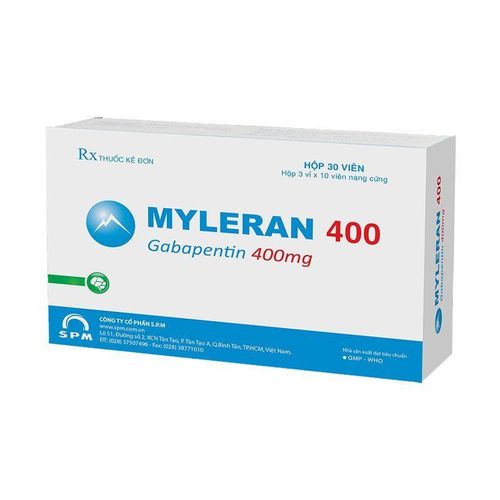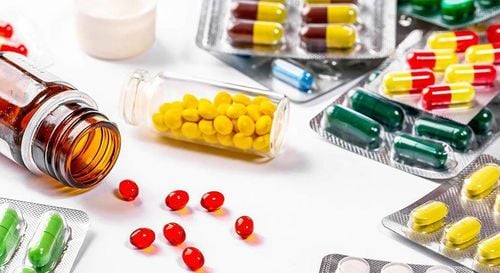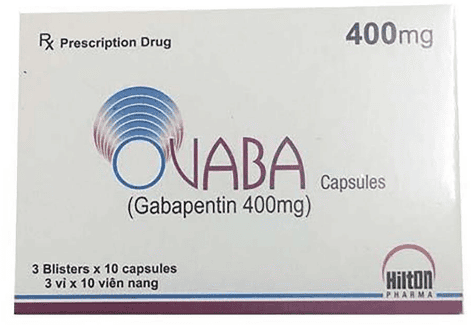This is an automatically translated article.
Gabaneutril is made in the form of hard capsules, with the main ingredient being Gabapentin. The drug is used in the treatment of epilepsy and peripheral neuropathy.
1. Uses of Gabaneutrile
Gabaneutril drug has many different strengths, typically Gabaneutril 100mg and Gabaneutril 300mg. This article mainly deals with Gabaneutril 300mg. 1 hard capsule of Gabaneutril 300mg contains the ingredient Gabapentin 300mg.
Gabapentin is an anticonvulsant drug used to treat epilepsy. Gabapentin is structurally related to the brain neurotransmitter gamma aminobutyric acid (GABA) in the brain.
Indications for use of Gabaneutril:
Epilepsy: Adjuvant treatment of partial seizures with/without secondary generalization in people aged 6 years and older; As monotherapy for the treatment of partial seizures with/without secondary generalization in persons 12 years of age and older' Peripheral neuropathy: Use in adults for the treatment of peripheral neuropathic pain marginal (such as postherpetic neuralgia, diabetic neuropathy). Contraindications to the use of Gabaneutril:
People with allergies, hypersensitivity to Gabapentin ingredients or other excipients.
2. Usage and dosage of Gabaneutrile
Usage: Orally, with or without food.
Dosage: The regimen used to treat adults and children 12 years of age and older is: 300mg/time/day on Day 1; day 2 use 300mg / time x 2 times / day; Day 3 use 300mg / time x 3 times / day. If gabapentin must be discontinued, it should be discontinued gradually over a minimum of 1 week.
Specific dosage is as follows:
Epilepsy: Often requires long-term treatment. The dose prescribed by the doctor depends on the patient's tolerability and effectiveness of the drug: Adults and adolescents: The effective dose range of Gabapentin is 900 - 3600mg/day. Treatment can be started with the above standard dose or 300mg/time x 3 times/day on the first day. Thereafter, based on the patient's response and tolerability, the dose was increased by 300 mg/day, gradually increasing every 2-3 days until a maximum dose of 3600 mg/day was reached. It takes about 1 week to reach the 1800mg/day dose; 2 weeks to reach 2400mg/day and 3 weeks to reach 3600mg/day. The total daily dose should be divided into 3 small doses, the maximum interval between 2 doses should not exceed 12 hours to avoid flare-ups of convulsions; Children 6 years and older: The starting dose is 10-15mg/kg/day, divided into 3 doses. The effective dose level in this subject is 25-35m/kg/day. The total daily dose should be divided into 3 small doses, the maximum interval between 2 doses should not exceed 12 hours; Peripheral neuropathic pain in adults: Treatment can be initiated with the above standard dose or 300mg/time x 3 times/day. Thereafter, based on the patient's response and tolerability, the dose was increased by 300 mg/day, gradually increasing every 2-3 days until a maximum dose of 3600 mg/day was reached. It takes about 1 week to reach the 1800mg/day dose; 2 weeks to reach 2400mg/day and 3 weeks to reach 3600mg/day. Currently, the effectiveness and safety of the drug has not been evaluated if used for more than 5 months to treat peripheral neuropathic pain. If the patient recommends taking the drug for more than 5 months, the physician should assess the patient's clinical condition and make a decision whether an extension of time is needed. In patients with poor health such as low weight, after organ transplant surgery, etc., the dose should be adjusted at a slower rate (use lower doses, prolong the time between dose increases). . Dosage for other subjects:
Elderly (over 65 years old): Dosage adjustment may be necessary if renal function is impaired. The risk of somnolence, asthma and peripheral edema is higher in the elderly; Patients with renal failure: Adjust dose according to creatinine clearance as follows: Clcr ≥ 80ml/min: Use dose 900 - 3600 mg/day (divided into 3 times/day); Clcr 50 - 70ml/min: Dose 600 - 1800 mg/day (divided into 3 times/day); Clcr 30 - 49ml/min: 300-900 mg/day (divided into 3 times/day); Clcr 15 - 29ml/min: Use a dose of 150 - 600 mg/day (should take a dose of 300mg, taken every other day); Clcr < 15ml/min: Use dose 150 - 600 mg/day (reduce dose in proportion to creatinine clearance); Patients on hemodialysis: Patients on hemodialysis and have never used Gabapentin: Use a starting dose of 300-400mg, then 200-300mg after each dialysis session lasting 4 hours; Do not use Gabapentin on non-dialysis days; The maintenance dose of Gabapentin is based on the recommended dose for patients with renal impairment. In addition to the maintenance dose level, an additional dose of 200-300 mg should be administered after each 4-hour dialysis session.
3. Gabaneutrile side effects
Some side effects patients may encounter when using Gabaneutril include:
Very common: Viral infection, drowsiness, dizziness, ataxia, fatigue, fever; Common: Pneumonia, urinary tract infection, respiratory tract infection, otitis media, leukopenia, infection, anorexia, increased appetite, confusion, antagonistic attitude, emotional, anxiety, depression, nervousness, abnormal anxiety, convulsions, dysarthria, hyperactivity, forgetfulness, insomnia, tremors, headache, paresthesia, abnormality in coordination, decreased sensation, convulsions eyeballs, increase/decrease/loss of reflexes, visual abnormalities (decreased vision, diplopia), dizziness, hypertension, vasodilation, bronchitis, dyspnea, pharyngitis, cough, rhinitis, sadness vomiting, vomiting, gingivitis, abdominal pain, indigestion, diarrhea, constipation, dry mouth or throat, flatulence, facial swelling, purpura (like bruises from physical trauma), itchy skin , rash, acne, joint pain, muscle spasms, muscle pain, back pain, impotence, weight gain, accidental injury, skin abrasions, broken bones; Uncommon: Allergic reactions (urticaria), hyperglycemia (common in diabetics), mental decline, decreased motor function, palpitations, generalized edema, increased ALT, increased AST and increased bilirubin, falls; Rare: Hypoglycaemia (common in diabetics), loss of consciousness, respiratory depression; Frequency not known: Thrombocytopenia, hypersensitivity syndrome (fever, rash, eosinophilia, lymphadenopathy, hepatitis), anaphylaxis, hyponatremia, hallucinations, confusion movement (dance, dystonia), tinnitus, pancreatitis, jaundice, angioedema, erythema multiforme, Stevens-Johnson syndrome, alopecia, drug rash with eosinophilia, convulsions myoclonus, rhabdomyolysis, acute renal failure, urinary incontinence, gynecomastia, sexual dysfunction (change in libido, impaired ejaculation, failure to achieve orgasm), withdrawal reactions (anxiety, insomnia, pain, sweating, nausea), changes in blood glucose levels in diabetics, increased blood creatine phosphokinase. When experiencing side effects of Gabaneutril, patients should consult a doctor and may have to stop treatment if there are serious and dangerous conditions.
4. Caution when using Gabaneutrile
Some notes patients need to remember before and while taking Gabaneutril:
If you want to reduce the dose or stop taking the drug, it should be done slowly for at least 1 week (for epileptic indications); Gabaneutril should be used with caution in pregnant and lactating women, driving vehicles and operating machinery.
5. Gabaneutrile drug interactions
Some drug interactions of Gabaneutril include:
There have been cases of respiratory depression, decreased alertness when using Gabapentin and Opioids simultaneously. Therefore, caution should be exercised when combining these two drugs, especially in elderly patients; Co-administration of Gabapentin with antacids containing aluminum and magnesium salts reduces the bioavailability of Gabapentin by approximately 20%. Therefore, Gabapentin should be taken approximately 2 hours after taking the antacid; Renal excretion of Gabapentin is slightly reduced when used in combination with cimetidine but this is not clinically significant When Gabaneutril is indicated, patients should strictly follow all instructions given by their physician to ensure the highest treatment effectiveness and reduce the risk of unpredictable events.
Follow Vinmec International General Hospital website to get more health, nutrition and beauty information to protect the health of yourself and your loved ones in your family.
Please dial HOTLINE for more information or register for an appointment HERE. Download MyVinmec app to make appointments faster and to manage your bookings easily.













